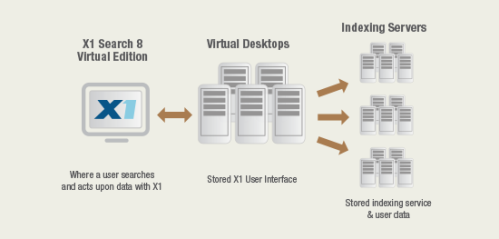by Barry Murphy
The new world of IT demands that enterprise software support varying infrastructures – traditional managed data centers, the cloud, hybrid and virtual environments. As a result, old-school approaches that once seemed logical no longer work in today’s reality. For example, tightly-coupled search appliances that marry hardware and software together no longer meet the requirements of enterprises that need to make distributed workers more productive no matter what kind of device they are on. It’s a new world for enterprise search and traditional solutions will have a very hard time adapting and scaling.
X1 is ready for the IT reality of always-on, virtual, cloud, and hybrid environments and business mobility. This is evidenced by two “firsts” that X1 is proud to announce. First, X1 is the first search application with an app publicly available in an Enterprise Mobility Management (EMM) app store. X1 Search Mobile is available in the AirWatch marketplace. Given the rapid move to mobile devices for work, this is no small news. Google just announced on Friday that searching the web is now predominantly done from mobile phones.
It’s clear, then, that enterprise search from the mobile device is now an essential requirement for business professionals. The mobile search app is important, but what X1 is building out is much more than that. In order to effectively deliver enterprise search from the mobile device requires having the back-end infrastructure to support full enterprise search in virtual environments. It also requires supporting the next-generation desktop (VDI or DaaS) where the users live. X1 has uniquely mastered such back-end infrastructure with the only desktop search (VDI or otherwise) and enterprise search solution that are VMware Ready certified.
The second “first” that X1 is proud of is the listing of X1 Rapid Discovery in the Amazon AWS Marketplace. Again, this is no small feat – this is the first enterprise-grade search and eDiscovery application to be available in the AWS Marketplace.
Organizations storing content in AWS can now get full-featured enterprise search and eDiscovery deployed right next to their content. And, if these organizations store other content locally, they can deploy Rapid Discovery in their own data center as well and have a single-pane-of-glass across all information no matter where it lives.
X1 will continue to provide solutions that work in the infrastructures that organizations utilize today. The traditional approach to search will not work, but with X1, companies will have the flexibility to deploy into any environment and give users a powerful search experience on any device. That is a powerful productivity tool – and businesses require worker productivity the same way humans require oxygen. It is a new enterprise search market out there and X1 is uniquely positioned to lead the charge.







